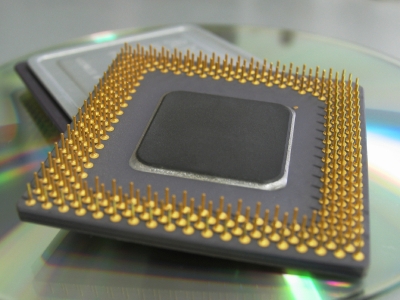Computer Hardware Terminology
32 Bit

32 bit parallel data bus processing
Do you know how many bits make up a
double word or four byte data bus?
That's right! You got it . . . 32!
32-bit first and foremost refers to the number of bits that can be processed or transmitted in parallel, that basically means at the same time as one.
As well as being the number of bits that can be used for single element in a data format, for example four Bytes (sometimes called Octets) or double word.
A Byte is eight bits wide and a word is sixteen bits wide. You could compare a byte to eight swimmers in swimming lanes swimming at same time. Or an eight lane motorway with a car in each lane side by side.
- The term ’32-bit’ is also applied to the following within:
- Microprocessors, indicating the width of the registers. A 32-bit microprocessor can process data and memory addresses that are represented by 32-bits.
- Data bus, indicating the physical number of wires in a data bus line. A 32-bit bus transmits 32 bits in parallel.
- Graphical device, such as a scanner or digital camera, specifying the number of bits used to represent each pixel. Typically 24 bits are used for true colour and the remaining 8 bits are used for control information.
- Operating system: refers primarily to the number of bits used to represent memory addresses.
Within computer architecture, 32-bit whole numbers (integers), memory addresses, or other data units are those that are at most 32-bits (four bytes or octets) wide.
The range of which whole number (integer values) can be stored in 32-bits is 0 to 4,294,967,295 or −2,147,483,648 to 2,147,483,647, using two's complement encoding.
Because of this, a processor with 32-bit memory address data lines can directly read/write 4 gigabytes (4,000,000,000 bytes) of byte addressable memory.
Also, 32-bit CPU and ALU architectures are those that are based on registers, address buses, or data buses of that size. 32-bit is also a term given to a generation of computers in which 32-bit processors were the norm. It had been the gold standard for computing for twenty years or so until recently.
The external address and data buses are often wider than 32-bits but both of these are stored and manipulated internally in the processor as 32-bit quantities. The Pentium Pro processor, for example, is a 32-bit processor machine, even so the external address bus lines are 36 bits wide, the external data bus lines are 64 bits wide.
Other prominent 32-bit processors also include the Intel 80386, the Intel 80486, and Pentium series, also the Motorola 68000 series. The Motorola 68000 is externally 16 bits long, never the less, it has 32-bit general purpose data registers, arithmetic units and is forwards-compatible with all 32-bit application software.
In images, 32-bit refers to 24-bit true colour images with an 8-bit alpha channel.
In 32 bits file format, a binary file format in which each elementary information is defined on 32 bits (or 4 Bytes).
Hopefully that's cleared the mud a bit, pardon the pun.
Go from 32 Bit back to Computer Hardware Terminology page.
Go onwards to Specification page.
Have a look at the latest pages updated here.
Return from 32 Bit page to Home page.
ARE YOU TIRED OF RISING FUEL PRICES!!!
Enjoy this page? Please pay it forward. Here's how...
Would you prefer to share this page with others by linking to it?
- Click on the HTML link code below.
- Copy and paste it, adding a note of your own, into your blog, a Web page, forums, a blog comment,
your Facebook account, or anywhere that someone would find this page valuable.